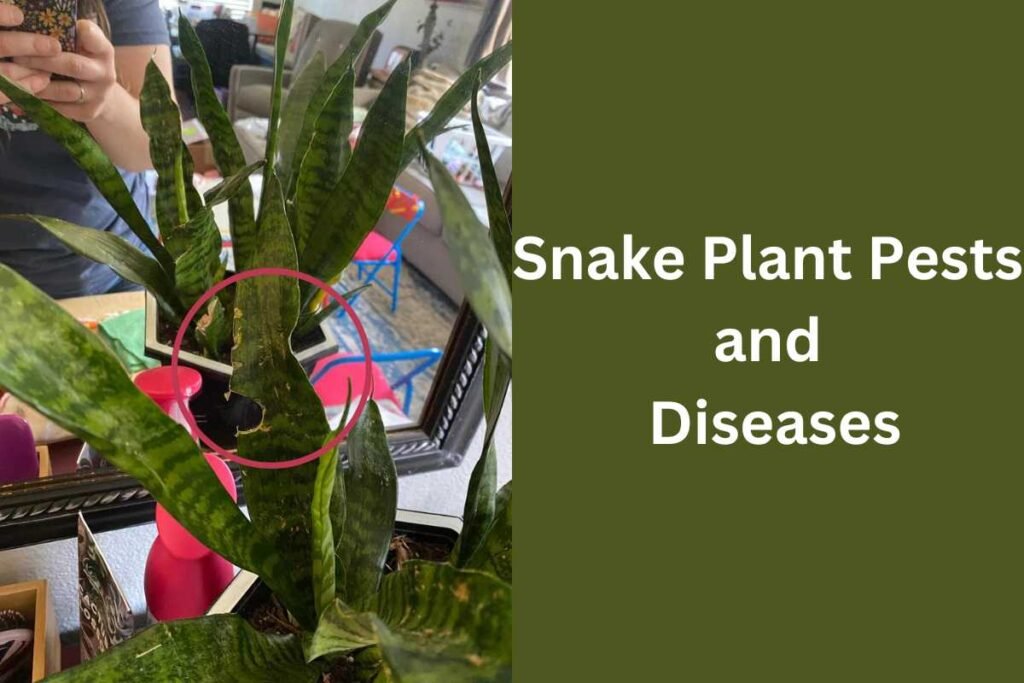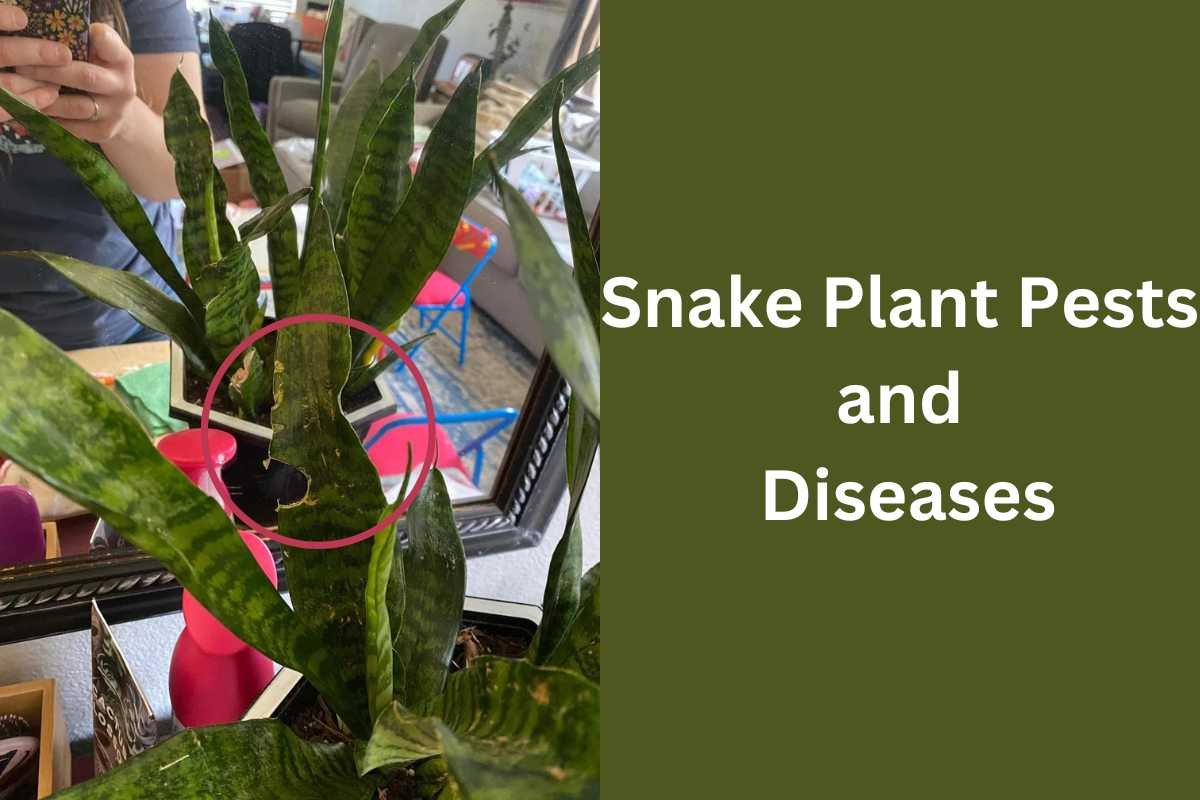The snake plant (Sansevieria trifasciata), often referred to as mother-in-law’s tongue, is one of the most popular houseplants worldwide.
Known for its easy-care nature, sleek appearance, and air-purifying capabilities, the snake plant is often chosen by beginner and seasoned gardeners alike.
However, despite its reputation as a hardy plant, the snake plant can still fall victim to a range of pests and diseases.
This blog post delves deep into the various pests and diseases that can affect the snake plant, their symptoms, how to identify them, and most importantly, how to prevent and treat them effectively.

Table of Contents
Understanding the Snake Plant’s Resilience
Snake plants are well-regarded for their resilience. They can survive in low light, tolerate drought, and even thrive in neglect.
Their thick, waxy leaves are designed to store water, making them ideal for low-maintenance indoor environments.
However, just like any living plant, they are not entirely immune to problems, particularly if their care is neglected or if environmental factors change drastically.
Common Pests of Snake Plants
While snake plants are relatively pest-resistant, certain insects can infest them, especially if grown in less-than-ideal conditions.
Let’s explore the common pests that can attack snake plants.
Spider Mites
- Description: Spider mites are tiny, spider-like creatures that are difficult to spot with the naked eye. They thrive in dry, warm environments and are most active during the winter months when indoor air is dry.
- Symptoms: Look for small yellow or white speckles on the leaves, which indicate the mites feeding on plant sap. If the infestation worsens, fine webbing may appear on the leaves.
- Treatment: Isolate the plant immediately. Spray the plant with water to dislodge mites, and wipe the leaves down with a damp cloth. In severe cases, insecticidal soap or neem oil can be used to treat the infestation.
- Prevention: Maintain high humidity around the plant by misting or using a humidifier. Regularly inspect the plant for early signs of infestation.
Mealybugs
- Description: Mealybugs are small, white, cotton-like insects that suck sap from the plant. They tend to gather in leaf joints or the undersides of the leaves.
- Symptoms: The presence of white, waxy deposits on the plant is a clear sign of a mealybug infestation. Affected leaves may yellow and droop.
- Treatment: Wipe the affected areas with a cotton swab dipped in rubbing alcohol. For larger infestations, insecticidal soap or neem oil can be used. Repeated treatments may be necessary to fully eradicate the pests.
- Prevention: Keep the plant clean and regularly inspect it for early signs of infestation. Isolate any new plants before introducing them to your collection.
Scale Insects
- Description: Scale insects appear as small, oval, or circular bumps on the plant. These hard-bodied insects attach themselves to the leaves and suck the sap.
- Symptoms: Leaves may become yellow and wilt, and the plant may exhibit slow growth. Sticky honeydew, a byproduct of scale insects, may also be present on the plant.
- Treatment: Manually remove the scales using a soft brush or a cotton swab dipped in rubbing alcohol. Horticultural oil or insecticidal soap can help in more severe cases.
- Prevention: Regularly inspect the plant, particularly the undersides of leaves. Isolate any new plants to prevent the spread of pests.
Fungus Gnats
- Description: Fungus gnats are tiny black flies that thrive in moist soil. While they don’t directly damage the plant, their larvae feed on organic matter in the soil, and in severe infestations, they can damage the plant’s roots.
- Symptoms: Adult gnats may be seen flying around the plant. The plant’s growth may slow, and in extreme cases, root damage can cause the plant to decline.
- Treatment: Allow the soil to dry out between waterings to reduce the larvae’s habitat. Sticky traps can be used to capture adult gnats. A soil drench with neem oil can help reduce larvae populations.
- Prevention: Avoid overwatering, and ensure the pot has good drainage. Consider using a well-draining soil mix.
Thrips
- Description: Thrips are small, slender insects that feed on the plant’s sap. They can cause significant damage to snake plants if left untreated.
- Symptoms: Thrips leave behind silvery streaks or blotches on the leaves. The leaves may also curl, and the plant may show signs of stunted growth.
- Treatment: Isolate the plant and treat it with insecticidal soap or neem oil. Thrips can be persistent, so multiple treatments may be necessary.
- Prevention: Regularly inspect the plant and maintain a clean growing environment. Avoid overcrowding plants to reduce the risk of infestation.
Common Diseases of Snake Plants
While pests are often more common, diseases can also afflict snake plants, particularly if they are exposed to excessive moisture or poor environmental conditions.
Let’s explore some of the diseases that can affect snake plants.
Root Rot
- Description: Root rot is a common problem in snake plants, typically caused by overwatering or poor drainage. It occurs when the plant’s roots remain in waterlogged soil, leading to fungal growth and decay.
- Symptoms: The plant’s leaves may become mushy, yellow, or wilted. When inspected, the roots appear black and mushy instead of firm and white.
- Treatment: Remove the plant from its pot and inspect the roots. Trim away any rotting roots and repot the plant in fresh, well-draining soil. Reduce watering and ensure the pot has adequate drainage.
- Prevention: Use a well-draining soil mix and ensure the pot has drainage holes. Allow the soil to dry out between waterings, especially during colder months when the plant’s growth slows.
Leaf Spot Disease
- Description: Leaf spot disease is caused by a fungal or bacterial infection. It manifests as small brown, black, or yellow spots on the leaves.
- Symptoms: The plant’s leaves develop small, irregularly shaped spots that may increase in size over time. In severe cases, the spots may coalesce, causing large areas of leaf tissue to die.
- Treatment: Remove the affected leaves to prevent the spread of the disease. Treat the plant with a fungicide if the problem persists.
- Prevention: Avoid overhead watering, as water on the leaves can encourage fungal growth. Ensure good air circulation around the plant.
Powdery Mildew
- Description: Powdery mildew is a fungal disease that appears as a white, powdery substance on the surface of the leaves.
- Symptoms: White powdery patches appear on the leaves, typically starting on the lower leaves and spreading upward. The leaves may become distorted or yellow over time.
- Treatment: Wipe the affected areas with a damp cloth and treat the plant with a fungicide or neem oil. Increase air circulation around the plant and reduce humidity.
- Prevention: Avoid overcrowding plants and ensure they have good air circulation. Water the plant at the base to keep the leaves dry.
Southern Blight
- Description: Southern blight is a soil-borne fungal disease that can cause severe damage to snake plants. It is caused by the Sclerotium rolfsii fungus.
- Symptoms: A white, cottony fungus appears at the base of the plant. As the disease progresses, the plant may wilt, and the leaves may become yellow or brown.
- Treatment: Remove the affected plant from the soil and discard any contaminated soil. Fungicide treatments can help, but prevention is the best approach.
- Prevention: Sterilize pots and tools before use. Use a well-draining soil mix and avoid overwatering.
Environmental Stressors and Their Impact on Snake Plants
In addition to pests and diseases, snake plants can be affected by environmental factors such as improper watering, poor lighting, or extreme temperature changes.
These stressors can weaken the plant and make it more susceptible to pest infestations and diseases.
Overwatering
Overwatering is one of the most common problems for snake plants. Since they are succulent-like, snake plants store water in their leaves and require less frequent watering than many other houseplants. Overwatering can lead to root rot, yellowing leaves, and overall decline.
Underwatering
While snake plants can tolerate drought, prolonged periods without water can cause the leaves to wrinkle, curl, or become crispy. However, underwatering is less common than overwatering.
Improper Lighting
Snake plants are versatile in terms of light requirements, but they thrive best in indirect bright light. Too much direct sunlight can scorch the leaves, while too little light can cause the plant to become leggy and weak.
Temperature Extremes
Snake plants prefer temperatures between 60-85°F (16-29°C). They are not frost-tolerant and can suffer from cold damage if exposed to temperatures below 50°F (10°C). Sudden temperature changes can cause leaf discoloration and wilting.
Preventing Pests and Diseases in Snake Plants
Prevention is always better than cure when it comes to plant care. By following these best practices, you can keep your snake plant healthy and free from pests and diseases:
Proper Watering Techniques
- Water your snake plant only when the top 1-2 inches of soil is dry.
- Use well-draining soil and pots with drainage holes to prevent water from pooling at the roots.
- Reduce watering during the winter months when the plant’s growth slows down.
Regular Inspections
- Regularly inspect your plant for signs of pests or diseases, especially on the undersides of leaves and near the soil line.
- Isolate new plants for a few weeks before introducing them to your other plants to prevent the spread of pests or diseases.
Maintain Ideal Growing Conditions
- Provide your snake plant with bright, indirect light and avoid exposing it to harsh, direct sunlight for long periods.
- Ensure good air circulation around the plant to prevent the buildup of humidity and discourage fungal growth.
Cleanliness
- Keep the plant’s leaves clean by wiping them with a damp cloth to remove dust and potential pests.
- Remove any dead or decaying leaves to prevent fungal or bacterial growth.
Treating a Severely Infested or Diseased Snake Plant
If your snake plant is severely infested with pests or diseases, you may need to take more drastic measures. Depending on the extent of the damage, here are some possible courses of action:
- Pruning: Remove heavily infested or diseased leaves to prevent the spread of pests or disease.
- Repotting: If the plant has root rot or is infested with soil-borne pests, repotting it in fresh soil may be necessary.
- Quarantine: Isolate the affected plant to prevent the infestation or disease from spreading to your other plants.
- Discarding the Plant: In extreme cases, it may be best to discard the plant to protect your other plants from a serious infestation or disease outbreak.
FAQs:
1. Why are my snake plant’s leaves turning yellow?
Yellowing leaves on a snake plant can be caused by several factors:
- Overwatering: This is the most common reason for yellow leaves. Excess water leads to root rot, causing the plant to struggle in absorbing nutrients.
- Underwatering: Prolonged drought may also cause the leaves to yellow, though this is less common.
- Pests: Infestations from mealybugs, spider mites, or scale insects can also cause yellowing.
- Improper light: Too much direct sunlight or very low light conditions can result in yellow leaves.
2. How do I know if my snake plant has root rot?
Signs of root rot in a snake plant include:
- Soft, mushy leaves: Often, the leaves may feel squishy or waterlogged.
- Yellowing leaves: Overwatering leads to root rot, which in turn causes yellowing.
- Foul odor: Root rot typically comes with a bad smell emanating from the soil.
- Brown or black roots: Healthy roots should be white and firm; rotted roots will appear brown or black and feel mushy.
3. How often should I water my snake plant?
Snake plants should be watered only when the top 1-2 inches of soil are dry. This could be every 2-3 weeks during warmer months and even less in winter. Overwatering is one of the most common causes of snake plant problems.
4. What are the tiny black flies around my snake plant?
These are likely fungus gnats. They thrive in moist soil and their larvae can damage the plant’s roots if left untreated. Allow the soil to dry between waterings, and use sticky traps to catch adult gnats.
5. How do I get rid of spider mites on my snake plant?
To eliminate spider mites:
- Wipe the leaves with a damp cloth or spray them with water to remove mites.
- Increase humidity around the plant, as spider mites thrive in dry conditions.
- Use insecticidal soap or neem oil if the infestation is severe. Be sure to isolate the plant to prevent mites from spreading to others.
6. Can I save a snake plant with root rot?
Yes, if the rot is caught early. Remove the plant from its pot, trim away the rotted roots, and repot it in fresh, well-draining soil. Reduce watering to prevent the issue from recurring.
7. What are the white cotton-like clusters on my snake plant?
These are likely mealybugs, which are small, sap-sucking insects. Wipe the affected areas with rubbing alcohol, and use insecticidal soap or neem oil for larger infestations.
8. How can I prevent pests from infesting my snake plant?
- Regular inspection: Check the plant regularly, particularly under the leaves and near the soil line.
- Isolate new plants: Quarantine new plants for a few weeks before placing them near your other plants.
- Proper care: Keep the plant healthy by providing adequate light, water, and a clean environment, which helps ward off pests.
9. What causes brown spots on my snake plant’s leaves?
Brown spots may be a result of:
- Leaf spot disease: A fungal or bacterial infection that causes small brown or black spots.
- Overwatering: Water sitting on the leaves can encourage fungal growth.
- Sunburn: Too much direct sunlight can scorch the leaves, causing brown patches.
10. Can I use chemical pesticides on my snake plant?
While you can use chemical pesticides, it’s generally better to start with organic or natural options like neem oil, insecticidal soap, or horticultural oils. Chemical pesticides can sometimes damage the plant, and they may harm beneficial insects as well.
Conclusion
Snake plants are hardy and resilient, but they are not completely immune to pests and diseases. By understanding the common issues that can affect snake plants, you can take steps to prevent and treat these problems, ensuring that your plant remains healthy and thriving.
Regular inspections, proper watering, and maintaining ideal growing conditions are key to keeping your snake plant pest and disease-free.
If your plant does become infested or infected, prompt action can help save it and restore it to good health.
With proper care, your snake plant can continue to grow and purify the air in your home for years to come.
My name is Shahriar Robin, and my journey with plants began in childhood, igniting a lifelong passion that blossomed alongside my career as a nutritionist and sports trainer. Through SnakePlant.org, I channel this dedication, merging expertise from nutrition and sports training to nurture a platform sharing all-encompassing knowledge about Snake plants. This website mirrors my commitment to cultivating greenery, offering comprehensive insights on growth, maintenance, and nurturing practices for these captivating plants. My mission is rooted in leveraging diverse expertise to enhance plant care practices, believing profoundly in the therapeutic impact of nature. Join me on SnakePlant.org, where I unite a thriving community of enthusiasts, sharing experiences, insights, and the profound joys of planting.

